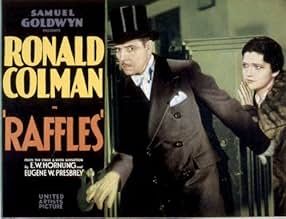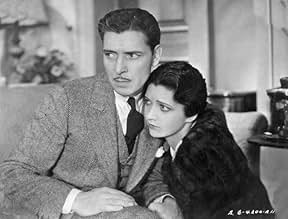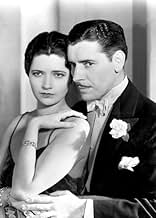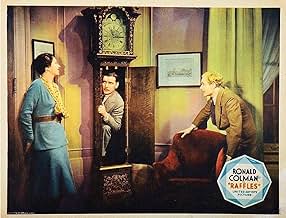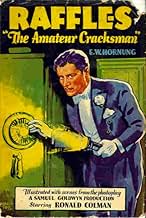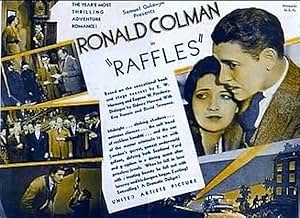Raffles
- 1930
- 1h 12min
Añade un argumento en tu idiomaA distinguished English gentleman has a secret life--he is the notorious jewel thief the press has dubbed "The Amateur Cracksman". When he meets a woman and falls in love he decides to "reti... Leer todoA distinguished English gentleman has a secret life--he is the notorious jewel thief the press has dubbed "The Amateur Cracksman". When he meets a woman and falls in love he decides to "retire" from that life, but an old friend comes to him with a predicament that entails him com... Leer todoA distinguished English gentleman has a secret life--he is the notorious jewel thief the press has dubbed "The Amateur Cracksman". When he meets a woman and falls in love he decides to "retire" from that life, but an old friend comes to him with a predicament that entails him committing one last job.
- Dirección
- Guión
- Reparto principal
- Nominado para 1 premio Óscar
- 2 premios y 1 nominación en total
- Lord Harry Melrose
- (as Frederic Kerr)
- Lord Melrose's Butler
- (sin acreditar)
- Harry - Lord & Lady Melrose's Friend
- (sin acreditar)
- Gwen's Friend
- (sin acreditar)
- Party Guest
- (sin acreditar)
Reseñas destacadas
Raffles is a British gentleman who supports himself by being a jewel thief - an amateur cracksman. The film opens with his burglary of a jewelry store with him leaving a calling card saying that this is his final burglary. He's fallen in love with Gwen (Kay Francis) and plans to leave this life behind because of his love for her. But then his friend Bunny appears, literally suicidal, and says he has written a bad check of one thousand pounds for gambling debts. His reputation will be ruined when the bank opens Monday morning and the check is known to be bad. So Raffles must pull one more job to help out his friend since he gave the jewelry in his last robbery to Gwen. He eyes the jewels of Lady Melrose as doing the job. Plus Bunny already has an invitation to go to the Melrose estate for the weekend for a big gathering that is going on there, so Raffles asks Bunny if he can go along. Realize that Raffles' criminal activity is a secret from everyone at this point - friends, family, servants.
But there are complications. Scotland Yard sends an inspector to the Melrose estate along with a cadre of cops because Scotland Yard thinks that the Amateur Cracksman will strike there that weekend. Also, there is a gang of burglars planning to steal the Melrose jewels themselves, under the cover of darkness. Then Gwen decides to pay a surprise visit to the Melrose estate, further complicating Raffles' plans to steal Lady Melrose's jewels.
I really can't say anymore without spoiling the fun for other viewers, but considering it is a very early talkie it is amazingly fluid and quite good at delivering suspense and comedy. Particularly amusing is Alison Skipworth as Lady Melrose. In her 50s, Melrose's heart still skips a beat around Raffles on who she obviously has a crush to the point that she talks about him in her sleep.
Dashing Ronald Coleman was unusual among silent cinema leading men in that his popularity was not diminished by the coming of sound. Many other leading men lost their popularity and their careers simply because they did not sound like what audiences expected. Colman had no such problem and with his excellent voice he was a natural with dialog. Watch this one and see what I mean. It delivers a great story well told, does not outstay its welcome, and supplies just the right amount of dialog.
Raffles has been a reformed ex-Cracksman for a few hours but finds he suddenly has to help his limp friend Bunny repay £1000 within 2 days and he only knows one way to get it. An invite to Lady Melrose's country house for cricket and a garden party of hundreds provides him with the chance and also a gang of six ineffectual Cockney burglars who skulk around in the dark loudly laying their plans. The scene where the burglar is caught and venomously points out Raffles on the stairs is pivotal to the film but it never recovers from the clumsy handling of it did Colman know what to say at that point? Colman was great in the role, his clipped accent and perfect diction usually used to good effect. Good support was from Kay Francis who played his understanding girlfriend although she didn't get to say Divine, and David Torrence the chunky and heavily cloaked Scotland Yard Inspector. Favourite bit: the torchlit confrontation between Raffles and Crawshay in the bedroom at midnight.
Simple old fashioned entertainment - I stick it on every few years without fail because with all its faults I like this one.
In the 1939 version, maybe because of the code, Raffles is a Robin Hood type who robs for the excitement and fun of it but then helps someone in need with the money or returns the merchandise. In this version, he steals, period, and in fact presents Gwen with a bracelet from one of his crimes. This film skips the whole beginning of the '39 film showing Raffles' acts of kindness, but the rest of the story is the same. Raffles decides to retire and start life anew with Gwen, but his friend Bunny shows up with a gambling problem and needs to cover a 1000 pound check by Monday. Raffles, alas, needs to do one more job.
Ronald Colman is delightful as Raffles, dashing, charming, and handsome as he cleverly attempts to escape the clutches of Scotland Yard. It's a wonderful role for him, as it was for David Niven in 1939. Kay Francis is wasted but is a good match for Coleman.
Fun film with a fine performance by Colman.
I'm a great fan of the Raffles books. E W Hornung the author was not so well known as his brother in law, Arthur Conan-Doyle but was though alround a better writer. This film is engaging and quite exciting, brings together parts from different stories and the result is entertaining but in terms of story, thin and slap-dash. The adaptation is dominated by the requirement to continue/assist Ronald Colman's highly bankable screen persona as an elegant, humorous, charming pleaser of ladies.(Raffles in the book is too dedicated to be humorous or charming unless necessary in pursuit of crime). Here Raffles love interest, Kay Francis, is very passionate, unlimited in her devotion to him. Of the two other central characters, companion in crime "Bunny" Manders is reduced to an irrelevance. Curiously the third character in the trio - McKenzie, the "Scotch" detective - alone is the all-time definitive rendering of the character in the book - Raffles' feared Nemesis: dogged, doughty and determined. Indeed the adaptation gives him equal billing with his quarry. It's a joy to watch a character from the books so vividly and truthfully brought to life. Clearly whoever did the adaptation was more interested in and relished McKenzie more than the other two.
All in all, a good entertainment.
The Raffles stories were extremely popular and have been the subject of many film, theater, and television treatments. One of the best of these is this 1930, very early talkie starring cinema's quintessential English gentleman, Ronald Coleman. It's really quite a good film for its time, with an intelligent script, generally good acting (especially by Coleman and character actor Frederick Kerr, better known as Baron Frankenstein in James Whale's famous 1931 treatment of the monster story, who steals every scene he is in as a grouchy English lord.) Co-cinematographer Gregg Toland, who later worked on many Hollywood classics, is presumably responsible for the film's noirish, atmospheric lighting effects.
All in all, I'd say this entertaining film will still be enjoyed by today's audiences, and is a must see for fans of Coleman.
¿Sabías que...?
- CuriosidadesThe last Samuel Goldwyn movie to be shot simultaneously in silent and talkie versions.
- PifiasWhen the alarm goes off and the cat burglar is attempting to escape, Bunny's bedroom windows are show to be wide open, which would have prevented the alarm being set in the first place.
- Citas
Inspector McKenzie: Good heavens! In the tobacco! Well, I'll be...
A.J. Raffles: Yes, I thought that you would be.
- Versiones alternativasRaffles (1930) was made simultaneously in silent and talking versions. With almost all the theaters in the USA wired for sound, this was to be the last film that Samuel Goldwyn produced in this manner.
- ConexionesReferenced in El demonio es un pobre diablo (1936)
- Banda sonoraThe Blue Danube
(uncredited)
Written by Johann Strauss
Heard when Raffles takes Lady Melrose to her room.
Selecciones populares
- How long is Raffles?Con tecnología de Alexa
Detalles
Taquilla
- Recaudación en Estados Unidos y Canadá
- 1.000.000 US$
- Duración1 hora 12 minutos
- Color
- Mezcla de sonido
- Relación de aspecto
- 1.20 : 1
Contribuir a esta página


